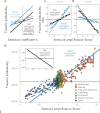This is a preprint.
Competition for resources can reshape the evolutionary properties of spatial structure
- PMID: 38659847
- PMCID: PMC11042312
- DOI: 10.1101/2024.04.13.589370
Competition for resources can reshape the evolutionary properties of spatial structure
Update in
-
Competition for resources can reshape the evolutionary properties of spatial structure.PLoS Comput Biol. 2024 Nov 22;20(11):e1012542. doi: 10.1371/journal.pcbi.1012542. eCollection 2024 Nov. PLoS Comput Biol. 2024. PMID: 39576832 Free PMC article.
Abstract
Many evolving ecosystems have spatial structures that can be conceptualized as networks, with nodes representing individuals or homogeneous subpopulations and links the patterns of interaction and replacement between them. Prior models of evolution on networks do not take ecological niche differences and eco-evolutionary interplay into account. Here, we combine a resource competition model with evolutionary graph theory to study how heterogeneous topological structure shapes evolutionary dynamics under global frequency-dependent ecological interactions. We find that the addition of ecological competition for resources can produce a reversal of roles between amplifier and suppressor networks for deleterious mutants entering the population. Moreover, we show that this effect is a non-linear function of ecological niche overlap and discuss intuition for the observed dynamics using simulations and analytical approximations.
Keywords: eco-evolutionary dynamics; evolutionary graph theory; generalist populations; graph-structured populations; population structure; probabilities of fixation; specialist populations; time to fixation.
Figures





Similar articles
-
Competition for resources can reshape the evolutionary properties of spatial structure.PLoS Comput Biol. 2024 Nov 22;20(11):e1012542. doi: 10.1371/journal.pcbi.1012542. eCollection 2024 Nov. PLoS Comput Biol. 2024. PMID: 39576832 Free PMC article.
-
A theory of evolutionary dynamics on any complex population structure reveals stem cell niche architecture as a spatial suppressor of selection.Nat Commun. 2024 May 31;15(1):4666. doi: 10.1038/s41467-024-48617-2. Nat Commun. 2024. PMID: 38821923 Free PMC article.
-
Evolutionary graph theory derived from eco-evolutionary dynamics.J Theor Biol. 2021 Jun 21;519:110648. doi: 10.1016/j.jtbi.2021.110648. Epub 2021 Feb 23. J Theor Biol. 2021. PMID: 33636202
-
Eco-evolutionary dynamics in a disturbed world: implications for the maintenance of ecological networks.F1000Res. 2019 Jan 24;8:F1000 Faculty Rev-97. doi: 10.12688/f1000research.15629.1. eCollection 2019. F1000Res. 2019. PMID: 30728953 Free PMC article. Review.
-
Eco-Evolutionary Dynamics: The Predator-Prey Adaptive Play and the Ecological Theater.Yale J Biol Med. 2018 Dec 21;91(4):481-489. eCollection 2018 Dec. Yale J Biol Med. 2018. PMID: 30588213 Free PMC article. Review.
References
-
- Allen Benjamin, Lippner Gabor, Chen Yu-Ting, Fotouhi Babak, Momeni Naghmeh, Yau Shing-Tung, and Nowak Martin A.. Evolutionary dynamics on any population structure. Nature, 544:227 EP –, 2017. - PubMed
-
- Altrock Philipp M and Traulsen Arne. Fixation times in evolutionary games under weak selection. New Journal of Physics, 11(1):013012, 2009.
-
- Altrock Philipp M, Traulsen Arne, and Nowak Martin A. Evolutionary games on cycles with strong selection. Physical Review E, 95(2):022407, 2017. - PubMed
Publication types
Grants and funding
LinkOut - more resources
Full Text Sources
